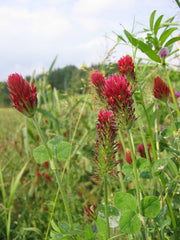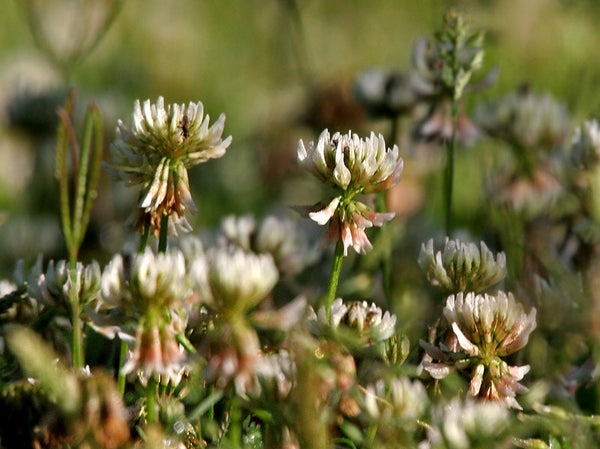Ladino white clover
Trifolium repensSOWING
Sow directly into a prepared seedbed or directly into an established grass. Persists more in competition with grass when grazed or mowed and irrigated. It is more difficult to establish into a grass sod than a prepared seedbed due to competition from the grass for light and moisture. A high proportion of hard seed, 30-40%. Inoculate to reduce the hard seed since these may germinate over time following abrasion by fluctuating soil conditions after sowing.
ADAPTATION
As a pasture plant, white clover yields are greatest in mild humid climates, such as New Zealand, the Pacific Northwest, the eastern half of the U.S., northern Europe, and along river valleys and in irrigated pastures of the intermountain region. White clover, a long lived stononiferous perennial, is bet adapted to well drained silt loam and clay soils with a pH range from 6.0 to 7.0 in humid and irrigated areas. With adequate soil moisture and fertility, it can be grown on sandy soils. It is not tolerant of saline or highly alkaline soils. Requires 18” of annual precipitation. Semi-drought tolerant, will not persist in long-dry summers in maritime climates of the west central and south coast without irrigation.
MANAGEMENT
The plant is shallow rooted, seldom goes deeper than 2 feet. White clover ranges from a perennial plant in the temperate zones to a winter annual in subtropical areas. Proper management of white clover grass pastures includes grazing or clipping to prevent excessive growth and competition from the grasses. The larger white clover require rotational or controlled continuous grazing. Over consumption of white clover by ruminants may result in either bloat or reproductive problems. For pastures, it is almost always seeded with grass. It has been seeded alone for swine and poultry pastures.
SHIPPING COST
25-lb., 50-lb. and larger sizes ship via ground transportation. Select the appropriate Bulk Shipping option at checkout. We may email you additional shipping costs separately based on your total order weight, zone and palleting costs.
LEARN MORE
SARE and Managing Cover Crops Profitably, 3rd Edition.
Days from maturity calculated from the date of seeding. Average 800,000 seeds per pound, 46,900 seeds per ounce. Sow average 10 lb per acre, /4 lb. per 1,000 sq.ft. Usual seed life: 6–10 years.
Planting Depth 1/4"
Soil Temp. Germ. 68˚F
Days to Germ. 7–10
Plant Spacing 6–9.5”
Row Spacing 6–10”
Days To Maturity 60–70
Part Shade, Moist Well Drained
Ladino Seed Count
.25 Pound ≈ 113m seeds
1 Pound ≈ 454m seeds
5 Pounds ≈ 2,268m seeds
25 Pounds ≈ 11,340m seeds
50 Pounds ≈ 22,680m seeds
- 1/4 Pound$4.00
- 1 Pound$15.00
Trifolium repens is a species of clover native to the entire European continent, eastern Asia, northern Africa and Western Japan. Distribution extends from the Arctic regions of Russia and Canada to the subtropical areas of Australia and South America. Small, intermediate, and large white clover evolved on relatively infertile, medium fertile, and fertile soils respectively.


